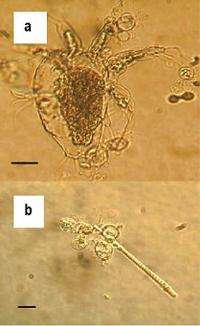December 18, 2012 report
Frog killing fungus found to infect crayfish too

(Phys.org)—A team of US biologists has found that the chytrid fungus, believed to be responsible for amphibian deaths worldwide, also infects and kills crayfish. In their paper published in the Proceedings of the National Academy of Sciences, the researchers write that their findings show that non-amphibian species can be infected by the fungus also, which helps explain how the fungus is able to persist in some lakes and ponds even after all of the amphibians in them have been killed.
The chytrid fungus (Batrachochytrium dendrobatidis) was only discovered in the late 1990's, but scientists believe it is responsible for widespread deaths of amphibians the world over. In just the past few decades, the fungus has wiped out entire populations of frogs and other amphibians bringing many to the brink of extinction. Until now, it was believed the fungus was only able to infect amphibians.
To try to understand why the fungus has been so successful and able to persist even after killing all its known hosts, the researchers looked at crayfish and mosquitofish to determine if it was possible that other species were being infected by the fungus as well. The team began by exposing specimens of both to the fungus in their lab. They found that most of the crayfish became infected (a third of them died), though the mosquitofish did not. Next, they put infected crayfish in with tadpoles and found the tadpoles became infected simply by existing in the same water as the infected crayfish. They also found that crayfish still became infected even after the water had been filtered to remove the fungus, indicating that a chemical was being released by the fungus that was able to cause infections as well. Following their findings in the lab, the team did some fieldwork in Louisiana and Colorado and found that 29 percent of crayfish caught in the wild had been infected by the fungus.
Because B. dendrobatidis has been found to persist in some ponds where there are no crayfish, the researchers suspect that they are not the only other species besides amphibians that can be infected and play host to the fungus. This, they say, likely explains how it is that the fungus came to be such a devastating pathogen.
More information: Chytrid fungus Batrachochytrium dendrobatidis has nonamphibian hosts and releases chemicals that cause pathology in the absence of infection, PNAS, Published online before print December 17, 2012, doi: 10.1073/pnas.1200592110
Abstract
Batrachochytrium dendrobatidis, a pathogenic chytrid fungus implicated in worldwide amphibian declines, is considered an amphibian specialist. Identification of nonamphibian hosts could help explain the virulence, heterogeneous distribution, variable rates of spread, and persistence of B. dendrobatidis in freshwater ecosystems even after amphibian extirpations. Here, we test whether mosquitofish (Gambusia holbrooki) and crayfish (Procambarus spp. and Orconectes virilis), which are syntopic with many amphibian species, are possible hosts for B. dendrobatidis. Field surveys in Louisiana and Colorado revealed that zoosporangia occur within crayfish gastrointestinal tracts, that B. dendrobatidis prevalence in crayfish was up to 29%, and that crayfish presence in Colorado wetlands was a positive predictor of B. dendrobatidis infections in cooccurring amphibians. In experiments, crayfish, but not mosquitofish, became infected with B. dendrobatidis, maintained the infection for at least 12 wk, and transmitted B. dendrobatidis to amphibians. Exposure to water that previously held B. dendrobatidis also caused significant crayfish mortality and gill recession. These results indicate that there are nonamphibian hosts for B. dendrobatidis and suggest that B. dendrobatidis releases a chemical that can cause host pathology, even in the absence of infection. Managing these biological reservoirs for B. dendrobatidis and identifying this chemical might provide new hope for imperiled amphibians.
Journal information: Proceedings of the National Academy of Sciences
© 2012 Phys.org

















